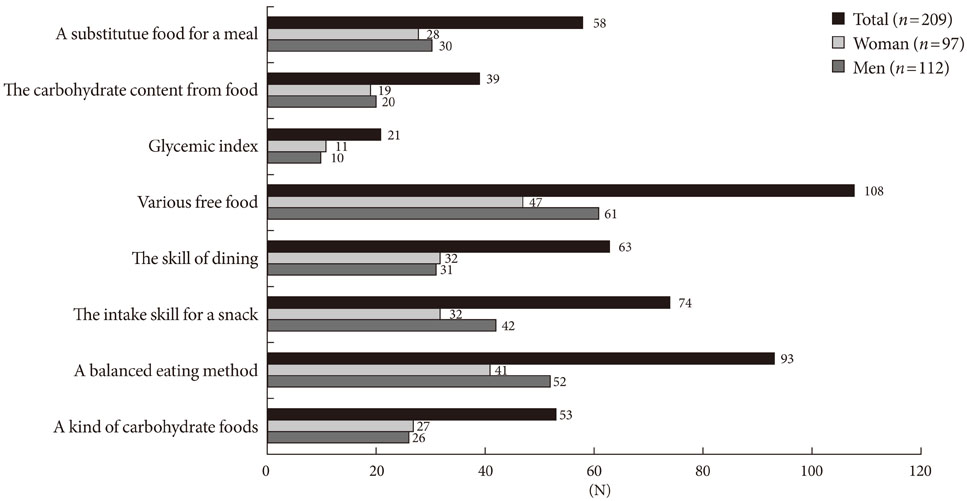Diabetes Metab J.
2011 Apr;35(2):173-181. 10.4093/dmj.2011.35.2.173.
A Survey of Diabetic Educators and Patients for the Revision of Korean Food Exchange Lists
- Affiliations
-
- 1Department of Dietetics, Samsung Medical Center, Seoul, Korea. janghak@snu.ac.kr
- 2Department of Nutrition, Boramae Medical Center, Seoul, Korea.
- 3Nutrition Care Services, Seoul National University Bundang Hospital, Seongnam, Korea.
- 4Department of Nutrition, Kyung Hee University Medical Center, Seoul, Korea.
- 5Department of Nutrition Service, Chung-Ang University Hospital, Seoul, Korea.
- 6Department of Food Service and Nutrition Care, Seoul National University Hospital, Seoul, Korea.
- 7Department of Internal Medicine, Boramae Medical Center, Seoul, Korea.
- 8Department of Endocrinology and Metabolism, Sejong General Hospital, Seoul, Korea.
- 9Department of Endocrinology and Metabolism, Ajou University School of Medicine, Suwon, Korea.
- 10Department of Internal Medicine, Chonbuk National University School of Medicine, Jeonju, Korea.
- 11Department of Pediatrics, Seoul National University College of Medicine, Seoul, Korea.
- 12Department of Internal Medicine, Yeungnam University College of Medicine, Daegu, Korea.
- 13Department of Internal Medicine, Seoul National University Bundang Hospital, Seoul National University College of Medicine, Seongnam, Korea. janghak@snu.ac.kr
- KMID: 2281716
- DOI: http://doi.org/10.4093/dmj.2011.35.2.173
Abstract
- BACKGROUND
Food exchange lists are one of the main methods of nutritional education. However, Korean food exchange lists have not been revised since 1994. Therefore, we surveyed the opinions of diabetes educators and patients with diabetes regarding the need for revision of the current food exchange lists.
METHODS
For two weeks beginning on 10 March 2008, a 12-item questionnaire regarding the opinion and need for revision of the current food exchange lists was e-mailed to diabetes educators nationwide. Another 15-question survey was administered to patients with diabetes in 13 hospitals located in the Seoul and Gyeonggi regions of Korea.
RESULTS
We obtained survey responses from 101 diabetes educators and 209 patients; 65 (64.3%) of the educators answered that the current food exchange lists should be revised. The items that needed revision were the glycemic index, addition of new foods and reaffirmation of exchange standard amounts. The patients demanded specific education about choosing appropriate foods, a balanced meal plan, proper snacks, and dining intake.
CONCLUSION
Our survey results demonstrate the need to revise the Korean food exchange lists. This process should focus on glycemic index, the addition of new foods and reconfirmation of one exchange reference unit.
Figure
Cited by 3 articles
-
Korean Food Exchange Lists for Diabetes: Revised 2010
Dal Lae Ju, Hak Chul Jang, Young Yun Cho, Jae Won Cho, Hye Sook Yoo, Kyung Suk Choi, Mi Hye Woo, Cheong Min Sohn, Yoo Kyoung Park, Ryowon Choue
Korean J Nutr. 2011;44(6):577-591. doi: 10.4163/kjn.2011.44.6.577.Korean Food Exchange Lists for Diabetes: Revised 2010
Dal Lae Ju, Hak Chul Jang, Young Yun Cho, Jae Won Cho, Hye Sook Yoo, Kyung Suk Choi, Mi Hye Woo, Cheong Min Sohn, Yoo Kyoung Park, Ryo Won Choue
J Korean Diabetes. 2011;12(4):228-244. doi: 10.4093/jkd.2011.12.4.228.How much fruit should diabetic patients eat?
Jeong Hyun Lim
J Korean Diabetes. 2014;15(4):185-189. doi: 10.4093/jkd.2014.15.4.185.
Reference
-
1. Korean Diabetes Association. Korean Dietetic Association. Korean Nutrition Society. Diabetes nutrition therapy manual. 1995. 2nd ed. Seoul: Medrang;19–20.2. Korean Diabetes Association. A status of international food exchange lists. Food nutrition workshop. 2001. Seoul: Korean Diabetes Association;3–13.3. Korean Diabetes Association, Food Nutrition Committee. A guide book of eating education for Korean patient with diabetes: a proposal. Diabetes Monit. 2000. 1:193–200.4. Wheeler ML, Franz M, Barrier P, Holler H, Cronmiller N, Delahanty LM. Macronutrient and energy database for the 1995 Exchange Lists for Meal Planning: a rationale for clinical practice decisions. J Am Diet Assoc. 1996. 96:1167–1171.5. Wheeler ML, Daly A, Evert A, Franz MJ, Geil P, Holzmeister LA, Kulkarni K, Loghmani E, Ross TA, Woolf P. Choose your foods: exchange list for diabetes, sixth edition, 2008: description and guidelines for use. J Am Diet Assoc. 2008. 108:883–888.6. Lee YN, Roh SY. The study of awareness and practice of Korean dietitians in food exchange lists, serving size and dietary guidelines. J Korean Diet Assoc. 2001. 7:9–18.7. Nurss JR, el-Kebbi IM, Gallina DL, Ziemer DC, Musey VC, Lewis S, Liao Q, Phillips LS. Diabetes in urban African Americans: functional health literacy of municipal hospital outpatients with diabetes. Diabetes Educ. 1997. 23:563–568.8. Ministry of Health and Welfare. Korea Centers for Disease Control and Prevention. Report on 2005 National Health and Nutrition Examination Survey-Nutrition Survey (KNHANES III). updated 2009 Mar 19. Available from: http://knhanes.cdc.go.kr.9. Ministry of Health and Welfare. Korea Centers for Disease Control and Prevention. Report on 2007 National Health and Nutrition Examination Survey-Nutrition Survey (KNHANES IV). updated 2009 Sep 28. Available from: http://knhanes.cdc.go.kr.10. Choi J, Moon HK. Comparison of dietary patterns by sex and urbanization in different economic status. Korean J Community Nutr. 2008. 13:346–358.11. Song YJ, Joung HJ, Paik HY. Socioeconomic, nutrient, and health risk factors associated with dietary patterns in adult populations from 2001 Korean National Health and Nutrition Survey. Korean J Nutr. 2005. 38:219–225.12. Daly A, Bolderman K, Franz M, Kulkarni K. Basic carbohydrate counting. 2003. Alexandria, Chicago: American Diabetes Association, American Dietetic Association.13. Kulkarni KD. Carbohydrate counting: a practical meal-planning option for people with diabetes. Clin Diabetes. 2005. 23:120–122.14. American Diabetes Association. Bantle JP, Wylie-Rosett J, Albright AL, Apovian CM, Clark NG, Franz MJ, Hoogwerf BJ, Lichtenstein AH, Mayer-Davis E, Mooradian AD, Wheeler ML. Nutrition recommendations and interventions for diabetes: a position statement of the American Diabetes Association. Diabetes Care. 2008. 31:Suppl 1. S61–S78.
- Full Text Links
- Actions
-
Cited
- CITED
-
- Close
- Share
- Similar articles
-
- Guidelines for the Use of 2023 Food Exchange Lists for Diabetes Meal Planning
- The Study of Awareness and Practice of Korean Dietitians in Food Exchange Lists, Serving Size and Dietary Guidelines
- Korean Food Exchange Lists for Diabetes: Revised 2010
- Korean Food Exchange Lists for Diabetes: Revised 2010
- A Basic Study of Food Exchange Database Construction and Search System (ENECC/E-Food Exchange) Based on Internet



